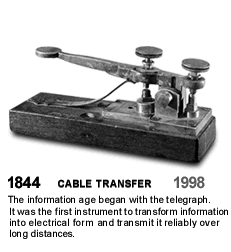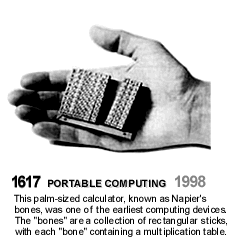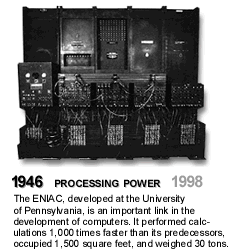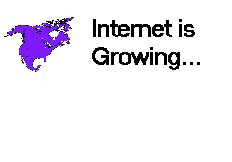![]() ND - Technology Illustrator
ND - Technology Illustrator 
In 1998, I saved these animated technology graphics from a University of Notre Dame Instructional Technology web page.
http://www.nd.edu/~ndoit I thought they were . . . "instructive."![]()
|
People talk at 300 to 500 words per minute. We type from 10 (?) to 325 wpm. . . . WOW! |
|
|
The PRODUCTI-VITY of PEOPLE and computers has increased. This old 45 RPM record played 2 to 6 minutes of music. Today's CD-ROM Disc holds 74 minutes of high quality (digital) music, or +/- 675 MEG of computer programs. DVD-ROM's hold 4.5 GIG of information. (music, pictures, data). |
|
|
|||
|
Remember the penny postcard? The 10¢ stamp? Time's changed! Today with a computer and modem, we can send "free E-mail" any place in the world. |
|
|
The "Virtuous Cycle" of computer processing. Quicker .. Faster .. Smaller .. Cheaper. Quicker .. Faster .. Smaller .. Cheaper. |
|
|
|||
|
The processing power of computers has been increasing since "Day 1" on an exponential basis. |
|
|
Remember the typewriter? Computers, and the processing power they provide, are no longer "the old typewriter" that many grew up with. Do they both have keyboards? "Yes." But, except for the keyboard, that's where the similarity ends. |
|
Internet Growth Map |
|||
|
|
|||
![]()
"Today (June, 1999) there are
150 million users of the Internet (world wide) and this number is increasing with 62,000 new users every day." *"Between 2005 and 2010 there will be 1 trillion users on the Internet." That's a trillion devices all hooked together!" *
"The Number 1 long-term issue facing the United States is 'the public school issue.' Our K-12 schools must turn out students that can read and write." *
- Mr. Louis Gerstner,Jr., Chmn & COO, IBM Corp on June 14th in testimony to Joint Committee investigating the "Impact of Technology on the US Economy".![]()
"The 'Digital Revolution' going on today is truly a profound change in our economic climate. It's having the same kind of profound effect on our economy as the Industrial Revolution had in the 1830's & '40s, and that "mass production" had in the 1920's. It's an 'intellectual based output system'". -
Allan Greenspan, Fed Chairman, June 14, 1999 in testimony to House Committee investigating the "Impact of Technology on the US Economy."![]()
|
The Internet and World Wide Web. Good or Bad?
|
"Two men sat behind jail-house bars. One saw mud ... the other saw stars!"
It all depends on where you sit and what cards you hold ... on your point-of-view.![]()
CONSIDERING ALL THE ABOVE ... a big issue is, "How to address the Information Overload confronting everyone?"
Restated
"With all information available (good and bad) in the world today, how do we provide some 'discipline to the process' so as to point students at some of the best information available ... so that some "disciplined learning" can be accomplished, turned-in, and otherwise measured/evaluated?" With only limited class hours available, how do we 'point' students at relevant class materials and have them use it productively, vis-a-vis spending limited, available class time "just surfing?"
Another "Frame of Reference":
Computers and the computer age have changed everything. The Information Age is alive and well; and is continuing to expand and offer information to anyone who desires access to that information. A primary source of access to information is the Internet.
The
Internet is truly a National educational resource and has changed the amount, type and quality of information available to all students.As a tool, the Internet contains a vast amount of truly outstanding information (read: "the best available, anywhere"). However; as a tool, the Internet also contains a good deal of "misinformation," "X-Rated" material, and "socially negative information" (e.g, skin head, "hate" and cult sites, etc.) which cannot be condoned by educators, parents and responsible students.
Additionally, as a tool, the Internet contains such a voluminous amount of information that the sheer volume of information available on any topic boggles the mind and can easily put the student into a state of "information overload" and/or intellectual inertia.
The CURRENT PROBLEM: Students are currently only receiving about
one hour of available research time each week on the Internet.Current classroom experience with students using the Internet as a reference resource indicates students spend approximately
75% of their available computer time searching for, researching and browsing for their topical reference material on the subject they are working on. Then they use only 25% of their alloted time using the information and completing their project.Productive time: = 25% of 1 hour = 15 minutes per week.
Among the biggest challenges faced by educators and students alike, is to find a way to access the best and most current information available on any given subject; --- and find the information in the least amount of time.
Anything that can be done to reduce, minimize, or help reverse the "75:25 Search to Use ratio" should help increase the actual amount of education that goes on in a classroom.
From this 1995 chart, you can see how the lifestyle of the American people has changed in the last 200 years. If anything, with the growth of the Internet in the last five year's, the number of American's engaged in Information is now at, or exceeds, the 50% level.
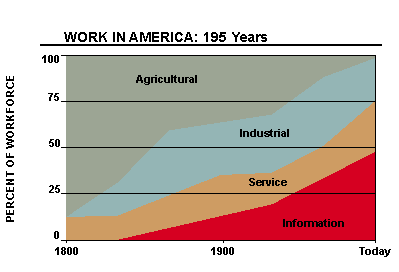
NOTE:
I found most of these graphics on the above Notre Dame University site. On checking back at the site every two to three months, sometimes they were there ... and sometimes they weren't. To put them all on one page to tell a different story, I downloaded them and used them, here. Thank you, Notre Dame - Bernie![]()
